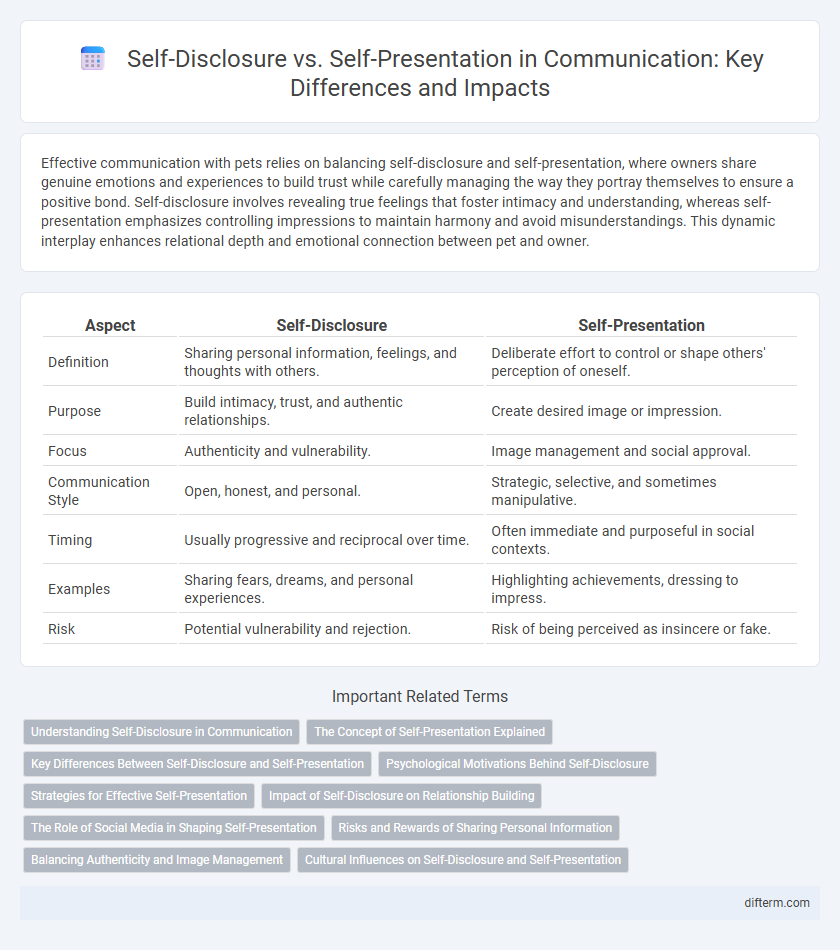Effective communication with pets relies on balancing self-disclosure and self-presentation, where owners share genuine emotions and experiences to build trust while carefully managing the way they portray themselves to ensure a positive bond. Self-disclosure involves revealing true feelings that foster intimacy and understanding, whereas self-presentation emphasizes controlling impressions to maintain harmony and avoid misunderstandings. This dynamic interplay enhances relational depth and emotional connection between pet and owner.
Table of Comparison
| Aspect | Self-Disclosure | Self-Presentation |
|---|---|---|
| Definition | Sharing personal information, feelings, and thoughts with others. | Deliberate effort to control or shape others' perception of oneself. |
| Purpose | Build intimacy, trust, and authentic relationships. | Create desired image or impression. |
| Focus | Authenticity and vulnerability. | Image management and social approval. |
| Communication Style | Open, honest, and personal. | Strategic, selective, and sometimes manipulative. |
| Timing | Usually progressive and reciprocal over time. | Often immediate and purposeful in social contexts. |
| Examples | Sharing fears, dreams, and personal experiences. | Highlighting achievements, dressing to impress. |
| Risk | Potential vulnerability and rejection. | Risk of being perceived as insincere or fake. |
Understanding Self-Disclosure in Communication
Self-disclosure in communication involves revealing personal thoughts, feelings, and experiences to build trust and deepen relationships, contrasting with self-presentation, which aims to control others' perceptions through selective information sharing. Understanding the balance between authenticity and impression management is crucial for effective interpersonal communication. Research highlights that appropriate self-disclosure enhances relational intimacy while excessive self-presentation can hinder genuine connections.
The Concept of Self-Presentation Explained
Self-presentation involves the deliberate process of controlling how one is perceived by others through behaviors, appearance, and verbal communication to create a desired impression. It differs from self-disclosure, which centers on revealing personal information to build intimacy or trust. Understanding self-presentation enhances effective communication by balancing authenticity with strategic image management.
Key Differences Between Self-Disclosure and Self-Presentation
Self-disclosure involves sharing personal, intimate information to build trust and deepen relationships, whereas self-presentation is the strategic display of one's image to influence others' perceptions. Self-disclosure emphasizes authenticity and vulnerability, while self-presentation focuses on controlling impressions to achieve social or professional objectives. Understanding these key differences enhances effective communication by balancing openness and image management.
Psychological Motivations Behind Self-Disclosure
Psychological motivations behind self-disclosure include the desire for emotional relief, building intimacy, and gaining social validation, contrasting with self-presentation which centers on managing impressions to control how others perceive us. Self-disclosure requires vulnerability and honesty, fostering trust and deeper connections, whereas self-presentation involves strategic behavior to enhance status or acceptance. Understanding these motivations helps in analyzing communication patterns within personal and professional relationships.
Strategies for Effective Self-Presentation
Effective self-presentation strategies involve balancing authenticity with audience awareness, ensuring messages align with social norms and expectations. Utilizing clear, confident verbal and nonverbal cues enhances trustworthiness and relatability in communication contexts. Tailoring disclosures to match the situation optimizes interpersonal connections without compromising personal boundaries.
Impact of Self-Disclosure on Relationship Building
Self-disclosure plays a crucial role in relationship building by fostering trust and emotional intimacy between individuals. Sharing personal thoughts and feelings allows for deeper connections and enhances mutual understanding, which significantly strengthens relational bonds. In contrast to self-presentation, which often aims to manage impressions, genuine self-disclosure promotes authenticity and long-term relationship development.
The Role of Social Media in Shaping Self-Presentation
Social media platforms significantly shape self-presentation by enabling users to curate and control the information they share, emphasizing idealized versions of themselves. The architecture of these platforms, with features such as likes, comments, and shares, influences users to engage in strategic self-disclosure that enhances their social image. Consequently, social media blurs the line between authentic self-disclosure and performative self-presentation, impacting interpersonal communication dynamics.
Risks and Rewards of Sharing Personal Information
Self-disclosure fosters trust and deeper connections by revealing authentic personal information, but it carries risks such as vulnerability to judgment or privacy breaches. Self-presentation strategically manages impressions to gain social approval or professional advantages, yet excessive image control may hinder genuine relationships. Balancing transparency and discretion is essential to navigate the potential benefits and drawbacks of sharing personal information in communication.
Balancing Authenticity and Image Management
Balancing authenticity and image management involves navigating the fine line between honest self-disclosure and strategic self-presentation. Effective communication requires individuals to share genuine thoughts and feelings while also tailoring information to fit social contexts and audience expectations. Maintaining this balance enhances trust and credibility without compromising personal or professional objectives.
Cultural Influences on Self-Disclosure and Self-Presentation
Cultural influences significantly shape self-disclosure and self-presentation, with collectivist cultures prioritizing group harmony and often limiting personal disclosures to maintain social cohesion. In contrast, individualistic cultures encourage openness and personal expression, leading to more frequent and detailed self-disclosures as a means of asserting individual identity. These cultural norms impact communication styles, affecting both the content and context in which self-presentation occurs, reflecting deeply ingrained societal values.
self-disclosure vs self-presentation Infographic

 difterm.com
difterm.com